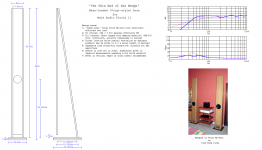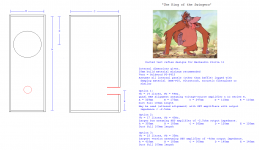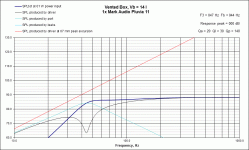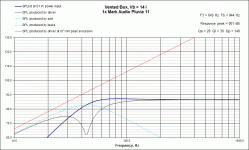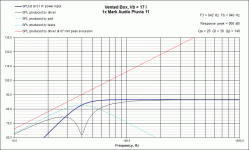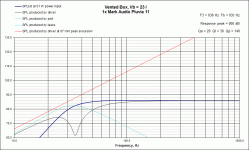How does MA Alpair 10.3 compare with pluvia 11?
Both are of same size and now the price of Alpair 10.3 have dropped and are slightly less than the pluvia 11. But Alpair 10p is at the same cost which is little higher among these.
Both are of same size and now the price of Alpair 10.3 have dropped and are slightly less than the pluvia 11. But Alpair 10p is at the same cost which is little higher among these.
How does MA Alpair 10.3 compare with pluvia 11?
Both are of same size and now the price of Alpair 10.3 have dropped and are slightly less than the pluvia 11. But Alpair 10p is at the same cost which is little higher among these.
You sure? To the best of my knowledge the price for Alpair 10 is apiece and the Pluvia for a pair, which for the dutch distributor means that the Alpair 10 is still almost twice as expensive.
You sure? To the best of my knowledge the price for Alpair 10 is apiece and the Pluvia for a pair, which for the dutch distributor means that the Alpair 10 is still almost twice as expensive.
https://www.madisoundspeakerstore.c.../markaudio-alpair-10-gold-6-full-range-gen-2/
Uh, I think Madisound and CSS's (the two NA resellers) pricing on all MA and Alpair drivers is per each. Where is does get confusing is that the 70mm and smaller drivers are packed and shipped in pairs, while the larger units are as singles.
That said, Madisound's current pricing on the the 10.3 is a very good deal - and coming from someone closer than either of us to the source, shouldn't be read as predicting any impending streamlining of product line by the manufacturer.
As to the original question - I think most folks who've heard both would take the sonic performance of either of the Alpair model over the roughly equivalent sized Pluvia - and for slightly lower cost, would be a no-brainer. Of course, it could be said that having limited higher cognitive function makes it easier for me to get there, and as the R&D continues, that performance margin could narrow.
That said, Madisound's current pricing on the the 10.3 is a very good deal - and coming from someone closer than either of us to the source, shouldn't be read as predicting any impending streamlining of product line by the manufacturer.
As to the original question - I think most folks who've heard both would take the sonic performance of either of the Alpair model over the roughly equivalent sized Pluvia - and for slightly lower cost, would be a no-brainer. Of course, it could be said that having limited higher cognitive function makes it easier for me to get there, and as the R&D continues, that performance margin could narrow.
Ah, yes, madisound has a screaming deal. Especialy with the dollar as it stands now; it's 149€ locally, so almost twice as dear.
it's the vagaries of currency exchange and international shipping - particularly if export documentation is incorrectly prepared- that can eat up all of the cost savings of such deals
sometimes you only need to cross the NA 49th parallel to find that out.
sometimes you only need to cross the NA 49th parallel to find that out.
Madisound Alpair 10.3
They had 35 in stock, now after me they have 33😀
Could not let this deal pass.
Thanks for the heads up.
Madisound's current pricing on the the 10.3
They had 35 in stock, now after me they have 33😀
Could not let this deal pass.
Thanks for the heads up.
The Pluvia 11 is a bit of a strange beast. In an optimum miniOnken it doesn’t go as low as the A10s or the Pluvia 7 (which goes lower yet). An optimum miniOnken for the P11 is 9 litres, for the P7 13 litres.
The Pluvias have a similar voicing to the Alpairs, but are not capable of as reproducing as much low level detail as the Alpairs (ie DDR is not as high in the Pluvia).
The Pluvias should be more durable thou as they have near twice the metal in the cone (A10.3 = 7.3 vrs P11= 11.4g). I can feel this different when treating the cone, and i had an accident with the P11 that would have dented an A10.3.
The Pluvia do sound good, don’t get me wrong, but they do not have the finese of the Alpairs.
I suspect that the A10.3 is on sale at Madisound because the metal cone driver has been outsold by the paper one in North America and they need to balance inventory.
dave
The Pluvias have a similar voicing to the Alpairs, but are not capable of as reproducing as much low level detail as the Alpairs (ie DDR is not as high in the Pluvia).
The Pluvias should be more durable thou as they have near twice the metal in the cone (A10.3 = 7.3 vrs P11= 11.4g). I can feel this different when treating the cone, and i had an accident with the P11 that would have dented an A10.3.
The Pluvia do sound good, don’t get me wrong, but they do not have the finese of the Alpairs.
I suspect that the A10.3 is on sale at Madisound because the metal cone driver has been outsold by the paper one in North America and they need to balance inventory.
dave
Dave,
How is the Pluvia 11 mid-bass performance? Given the stronger (and heavier) cone, and higher box tuning, I am curious on the real world results.
How is the Pluvia 11 mid-bass performance? Given the stronger (and heavier) cone, and higher box tuning, I am curious on the real world results.
The Pluvia 11 is a bit of a strange beast. In an optimum miniOnken it doesn’t go as low as the A10s or the Pluvia 7 (which goes lower yet).
dave
does Pluvia 7 goes lower than both alpair 10.3 and Pluvia 11?
Yes. In the right box.
dave
That does seems to be counterintuitive, and a major departure from the published specs.
Back to the drawing board I guess 🙂
Those are based on the extention achieved with our miniOnken enclosure alignment using factory specs.
dave
dave
Yes. In the right box.
dave
So pluvia 7 gives better frequency coverage than bigger alpair 10.3 and pluvia 11.
What enclosures works the best for pluvia 7? is it frugal horn?
is it better than alpair 10.3 or pluvia 11 in pencels?
The FHXL is tuned lower than the FH3 and the horn dominates wrt extension there. We have only tried the P7 in FH3 so far. I have a set of Thirlmire-R i have yet to load up… Besides being decent FR it should also make a good push-push helper woofer for uFonkens, uMar-Kens & the nScan-Ken.
The miniOnken enclosure tuning follows some very specific rules and extention results are comparable. The Alpair 10.2 goes the lowest with EL70 not far behind. Turns out P7 is optimal in the same size boxes with nigh on the same tuning so it has LF extension much the same as the EL70.
Now the larger drivers move more air and are capable of more impact.
The models don’t say anything about extension at the top end, but smaller drivers tend to be better,
dave
edit: thanx Zia
The miniOnken enclosure tuning follows some very specific rules and extention results are comparable. The Alpair 10.2 goes the lowest with EL70 not far behind. Turns out P7 is optimal in the same size boxes with nigh on the same tuning so it has LF extension much the same as the EL70.
Now the larger drivers move more air and are capable of more impact.
The models don’t say anything about extension at the top end, but smaller drivers tend to be better,
dave
edit: thanx Zia
Its little confusing.. i am novice regarding speakers..
My understanding is that small drivers will have good mid and high frequencies and will have week bass/low.. And a larger driver will have better bass/low frequencies and may be having a relatively weaker in high frequencies when compared with smaller drivers.
So if EL70 or Pluvia7 being smaller and stilling going lower than Alpair 10.3, then will they be producing better full sound than the bigger alpair 10.3?
If given a choice which one would be better to be picked Pluvia7 or alpair 10.3?
My understanding is that small drivers will have good mid and high frequencies and will have week bass/low.. And a larger driver will have better bass/low frequencies and may be having a relatively weaker in high frequencies when compared with smaller drivers.
So if EL70 or Pluvia7 being smaller and stilling going lower than Alpair 10.3, then will they be producing better full sound than the bigger alpair 10.3?
If given a choice which one would be better to be picked Pluvia7 or alpair 10.3?
My understanding is that small drivers will have good mid and high frequencies and will have week bass/low.. And a larger driver will have better bass/low frequencies and may be having a relatively weaker in high frequencies when compared with smaller drivers.
That is a reasonable generalization, but you have to pay attention to the detail when you get down to a driver.
One can go lower by sacrificing efficiency, or by needing a bigger box or both.
Optimum volume for our miniOnken tuning for the P7 is the same as the A10.3 (and since P7 is smaller it has a relatively larger box).
If given a choice which one would be better to be picked Pluvia7 or alpair 10.3?
A10.3
dave
I'd qualify that last by "depends on application", but certainly couldn't disagree on the 10.3 in an appropriate sized enclosure. From what I've heard so far of both models of the Pluvias and approximate same sized Alpairs, the latter have more detail / finesse - pick your favorite jargon.
Having one of my periodic sort-outs of files (I do, from time to time) & found a smattering of designs I'd partially worked up for the Pluvia 11, then put aside. Since there aren't all that many designs out there for the driver at the moment, I've stuck them in a couple of files in case they are of interest.
-One Voigt style ML-horn. A bit of fun, although it should actually be quite a decent performer, so I've stuffed the dimensions + a sketch into an image file. I must have had Yes Minister on in the background as I've called it The Thin End of the Wedge. And yes, it is 7ft tall (who was it who was saying the P11 wants a small box? 😉 ). And if anybody thinks that's excessive, of course it is. Horns & their variations are big. Live with it. 😉
As a design, it's closer to some of the Voigt pipes that were doing the rounds a few years back; it's mass-loaded but not heavily so compared to a lot, as I was targeting a higher efficiency load over a slightly wider gain BW, accepting a little more ripple in the response (mainly null associated with F3) as the trade-off. In practice you're likely to get more variation from room effects than the minor dip the box possesses. The plinth dimensions can be altered as preferred of course.
-A handful of BR boxes. Quick design studies; I tend to work up a few for new drivers out of interest, fixing the vent (in this case an inexpensive Goldwood job Madisound sell) dimensions & altering the volume & tuning to reflect any change in output impedance / series R in the circuit. They weren't originally done as finished designs, just quick checks, but they should work fine, so I've cobbled a file together with 3 of about a dozen variations I had on the HDD, with some suggested HxWxD dimensions. Since vented boxes assume Helmholtz conditions, these can be adjusted as preferred, so long as one is not stretched significantly relative to the others, which would increase the potential for standing waves to affect behaviour somewhat. Smallest one assumes a voltage source with an EBS[ish] alignment. You can use it on the end of a SET amp with an output impedance of up to about 2.5ohms. The alignment will change (see images), but remain quite usable. The middle one was specifically assuming amps with an output impedance of ~2.5ohms - 3ohms or so. The larger was for amps with an output impedance of about 3ohms - 4ohms. The plots show a reduction in SPL, as they were done quickly & I was fudging it by adding series R. The response profile should be fairly representative though, notwithstanding room effects. I usually like a damped alignment in practice, although I usually do boxes on the forum that are flatter on the assumption that people will adjust tuning to suit their requirements.
Edit -I've no idea why I called the vented boxes 'The King of the Swingers', but I had to call them something, and the ape always cracks me up, so that, as they say, is that.
-One Voigt style ML-horn. A bit of fun, although it should actually be quite a decent performer, so I've stuffed the dimensions + a sketch into an image file. I must have had Yes Minister on in the background as I've called it The Thin End of the Wedge. And yes, it is 7ft tall (who was it who was saying the P11 wants a small box? 😉 ). And if anybody thinks that's excessive, of course it is. Horns & their variations are big. Live with it. 😉
As a design, it's closer to some of the Voigt pipes that were doing the rounds a few years back; it's mass-loaded but not heavily so compared to a lot, as I was targeting a higher efficiency load over a slightly wider gain BW, accepting a little more ripple in the response (mainly null associated with F3) as the trade-off. In practice you're likely to get more variation from room effects than the minor dip the box possesses. The plinth dimensions can be altered as preferred of course.
-A handful of BR boxes. Quick design studies; I tend to work up a few for new drivers out of interest, fixing the vent (in this case an inexpensive Goldwood job Madisound sell) dimensions & altering the volume & tuning to reflect any change in output impedance / series R in the circuit. They weren't originally done as finished designs, just quick checks, but they should work fine, so I've cobbled a file together with 3 of about a dozen variations I had on the HDD, with some suggested HxWxD dimensions. Since vented boxes assume Helmholtz conditions, these can be adjusted as preferred, so long as one is not stretched significantly relative to the others, which would increase the potential for standing waves to affect behaviour somewhat. Smallest one assumes a voltage source with an EBS[ish] alignment. You can use it on the end of a SET amp with an output impedance of up to about 2.5ohms. The alignment will change (see images), but remain quite usable. The middle one was specifically assuming amps with an output impedance of ~2.5ohms - 3ohms or so. The larger was for amps with an output impedance of about 3ohms - 4ohms. The plots show a reduction in SPL, as they were done quickly & I was fudging it by adding series R. The response profile should be fairly representative though, notwithstanding room effects. I usually like a damped alignment in practice, although I usually do boxes on the forum that are flatter on the assumption that people will adjust tuning to suit their requirements.
Edit -I've no idea why I called the vented boxes 'The King of the Swingers', but I had to call them something, and the ape always cracks me up, so that, as they say, is that.
Attachments
Last edited:
- Home
- Loudspeakers
- Full Range
- MA alpair 10.3 vs pluvia 11
